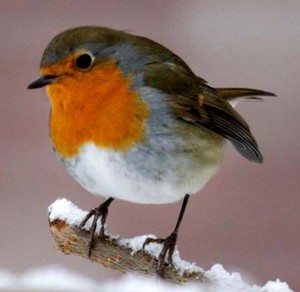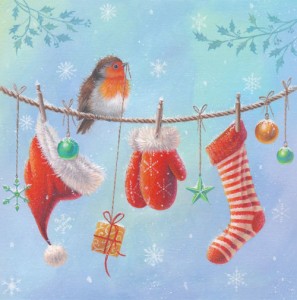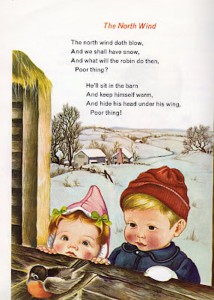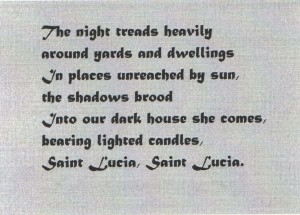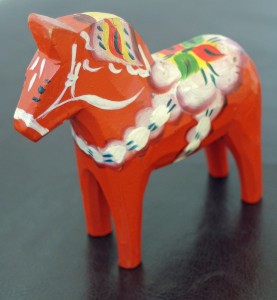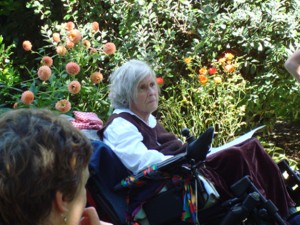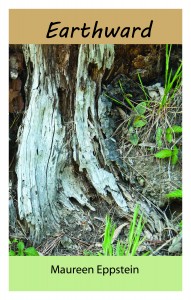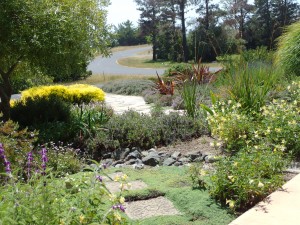Archive for the ‘spirituality’ Category
The woman on the moor
 The ring is nothing fancy: a cabochon of amethyst quartz clumsily set in a plain silver bezel. No magic symbols engraved on the back. Yet it is a talisman. Whenever I wear it, I hear in my mind the unspoken message of the woman who sold it to me.
The ring is nothing fancy: a cabochon of amethyst quartz clumsily set in a plain silver bezel. No magic symbols engraved on the back. Yet it is a talisman. Whenever I wear it, I hear in my mind the unspoken message of the woman who sold it to me.
The year was 1966. Knowing it might be our last year in England, our family (husband, two infant boys and me) took a summer trip through England and into Scotland, staying mostly in private homes that offered bed and breakfast. A farm in the Peak District of Derbyshire. Across the Yorkshire Dales to Huddersfield and Keithley, from whence my paternal grandfather had emigrated as a young man to New Zealand. Up to a gray stone village on the moors to take tea with a sweet great-aunt who had married and stayed behind when her siblings left, and whose knowledge of the whole New Zealand branch of the family put me to shame. The Lake District, lowering with storm clouds and redolent with Wordsworthian cadences. A stone circle near Keswick. Hadrian’s Wall, a loch in Scotland. Yellowing pictures now fill a photograph album.
The little roadside shop was somewhere in the northern hills of England, on our way home. A gray, damp day, a gray, bleak building. Nothing much else around. We all needed a break from driving, so we stopped. Quickly bored with the arts & crafts contents of the shop, our toddler and the baby drifted outside with their father. I lingered, drawn to the young woman attendant, who sat at a table threading beads into a necklace. A knitted shawl around her shoulders, long mousy hair falling in a braid down her back. We chatted. She had left an unhappy relationship and was determined to survive on her own.
She had the confidence I lacked. Brought up in a conservative culture and married young, I was struggling with a sense of powerlessness in my traditional wife-and-mother role. There were times I felt trapped, and thought of escaping with the children back to New Zealand. But this would have felt like defeat. Besides, it was impractical. I had no money to pay for fare, no clue about how I would manage on my own once I got home.
My encounter with the woman on the moor was brief. I never learned her name. But the amethyst ring symbolizes an unspoken pact between us. What I gave her was good wishes and payment for her work. What she gave me was confidence that I too could find my inner strength. This is what I remember when I wear it.
Robin redbreast on a fence
I still ponder why it meant so much, that Christmas morning in England in the 1960s, that a robin sat on the back fence. The field behind the fence was white, the fence wires thick with hoar frost, and the little red-breasted bird made the scene perfect. Finally, I told myself, a ‘real’ Christmas.
I have tried for many years to clarify my feelings about the disconnect between the traditional trappings of the season and my experience of growing up in New Zealand, where the seasons are reversed. My childhood Christmas memories are of summer: the tree laden with oranges in my grandmother’s garden where we hung our presents and picnicked on the lawn; the scent of magnolia blossom outside the church on Christmas Eve.
Also the Christmas cards with their images of snow (which I’d never experienced) and yes, the English robin. I knew about robin redbreast from the old nursery rhyme, but until that Christmas I hadn’t seen one.
Now on the coast of Northern California, I have a different understanding of how to celebrate the winter season. Our multicultural society recognizes many winter festival stories and traditions: the birth of Jesus in a stable, the menorah candles of Hannukah, the Swedish light-bringer St. Lucia, the gift-bringer St. Nicholas (known also as Santa Claus), and many others. The celebration that holds the deepest meaning for me now is Winter Solstice, the return of the light. From summer to winter, I note where on the horizon the sun sets, and how the darkness grows. Even as clouds gather, the place where sun disappears into ocean fogbank moves steadily to the south. When the prevailing westerly wind shifts to the southeast, I know to expect the winter rains. Sometimes a shower or two, sometimes, such as this past week, a prolonged deluge that floods rivers, downs power lines, and closes roads.
Meanwhile, the earliest spring flowers are breaking bud, and over-wintering birds gather hungrily at my feeder: Steller’s jay, spotted towhee, hermit thrush, acorn woodpecker, hordes of white-crowned sparrows. I love them dearly. I am happy that I have learned to understand the connection between the flow of seasons and human efforts to explain them with stories and festivals. And I still have a place in my heart for the memory of that cheery robin redbreast who brightened an English winter.
My first cuckoo
Sumer is icumen in
Lhude sing cuccu
Listen to this Medieval rote song
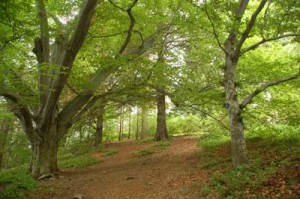
An English oak woodland. Image from Open University on the BBC
My first spring in England, late afternoon in Windsor Great Park. Green-gold light through ancient oaks, the air rich with leaf-mold and violets. A cuckoo calls. I have heard the sound all my life, in music and poems, but never before in the wild.
Listen to the cuckoo calling in this recording from the British Library
As I stand listening, this spring in 1962, something shifts in my thinking. It is as if previously I saw the world through two mesh screens, one named Southern Hemisphere and the other Northern Hemisphere, half a year out of alignment with each other, so that my view was blurred by the moiré patterns their meshes made. The religious festivals my ancestors brought from the northern hemisphere when they emigrated to New Zealand lost their old association with the seasonal cycles of life and death when celebrated in the reversed seasons of the southern hemisphere. In consequence, I felt, even as a child, a subtle sense of having been cut off at the roots, of being, even after several generations, transplanted British.
Images float into my mind. Mid-morning, Christmas Eve, at All Saints Church in Tauranga, NZ. Strewn mounds of flowers deck the chancel steps. The Altar Guild ladies are filling shiny brass vases that stand either side of a red-draped altar. Bronze-purple foliage of copper beech, fans of gladiolus spikes, the tropical exuberance of canna. They add dahlias, roses, bougainvillea until the reds vibrate.
Sunlight through stained glass glitters on the sharp points of holly springs that I strew along the dark wood windowsills, hiding jam jars filled with red geranium flowers. The holly bears no berry here, this time of year, and the carol I hum under my breath echoes in an empty place inside me. Later, at midnight services, the congregation sings of light in darkness and the falling of snow. We emerge to warm air, misty moonlight, and the scent of magnolias. This Christmas is not real, I think to myself. It’s pious make-believe.
Easter: after morning church and family lunch, I gather with siblings and cousins on the porch to smash the Easter eggs we have all been given. Molded of hard sugar, they are pastel pretty, with piped-on decorations of flowers and leaves, the symbols of spring. Having gorged ourselves, we scamper off to scuffle through autumnal leaves.
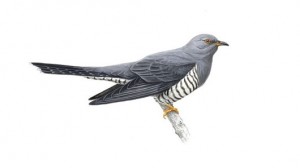
Cuckoo image from
Royal Society for the Protection of Birds
My reading in college, particularly J.G. Frazer’s The Golden Bough, helped me recognize that Christian festivals have pagan roots: the ritual victim dies at planting time; the winter birth is the rebirth of the sun. As the cuckoo calls again, cu-coo, over and over, quietly, the blurred meshes of my hemispheres resolve and I see through: myself and my people bound by tangled apron strings to the life our forbears left, and to the earth itself, an old reality, almost forgotten.
A Swedish Christmas in London
Last week we went to a Swedish party – the St. Lucia festival, I wrote to my parents from England in mid-December 1962. The background of it seems somewhat confused – the story of a saint mixed up with old pagan mid-winter rites.
My confused reaction to this experience opened me to the concept of cultural adaptation: the way stories and beliefs from one tradition are assimilated into another. Growing up as a Christian in New Zealand, where the seasons are the opposite of the Northern Hemisphere, I was aware of an odd disconnect in the trappings of our festivals, but as yet did not fully comprehend why this should be.
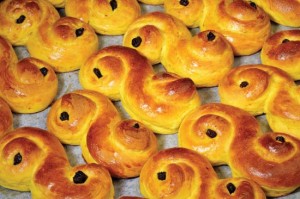
Saffron bread (lussekatter), traditionally served on St. Lucia’s Day. Image from Encyclopedia Britannica.
The event was also a fun field trip for our group of Swedish language students at the College of Further Education in Slough, west of London. Tony and I had become enamored of all things Scandinavian, and hoped to go there one day. Our teacher, Ingrid, the daughter of a diplomat based in London, was eager to introduce us to London’s Swedish community. I tried to summarize her explanation of the festival in my letter, which continues:
The cattle were slaughtered about Dec. 13 for Christmas, and the women used to come out early in the morning with the men’s breakfast. It developed into a ceremony in which a young girl, attended by maidens and young boys, & wearing a head-dress of candles on her head, goes early in the morning to the homes of people in the district bringing hot coffee. Apparently in Stockholm anyway it has developed into a sort of beauty contest, but in London the Swedes are more Swedish than at home & we saw a more genuine procession of children (the little boys looking very self-conscious) singing charming old Swedish carols, & all carrying candles in the darkened room. Very effective & beautiful. The evening finished with coffee & Swedish cakes & pastries at candle-lit tables.
I later learned that before the Christian west adopted the Gregorian calendar in the late 1500s, St. Lucia’s Day fell on the winter solstice, and that it originally honored a goddess who brings the light in the dark Swedish winters. Traces of this solstice celebration linger in the words of the carols sung by the children.
The event we attended at the Swedish church in London also included a crafts fair, which I wrote about for my New Zealand newspaper. Here is the text:
SWEDISH CHRISTMAS DECORATIONS
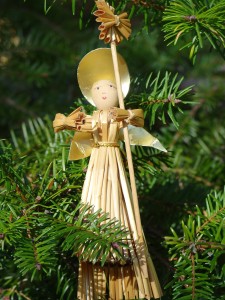
The straw angel we bought at the church fair. Battered but loved, she still graces the top of our tree.
Our Christmas tree will be decorated with a Swedish angel this year. She is made out of barley straw, pale shining gold pieces neatly tied together. In the early days in Sweden, when the floors of homes were covered with straw to keep out the bitter cold, Christmas guests used to play with the shining straws, plaiting and twisting them into quaint figures. Now Swedish houses are centrally heated, but the custom has persisted, and wherever in the world Swedish people live, at Christmas their homes are always decorated with the golden figures and wreaths.
The Swedish community in London recently held their annual church fair, and out came the traditional Christmas gifts and decorations. As well as the charming angels, there were straw animals, goats and horses and dogs, and handsome plaited wreaths for hanging at the door. Other figures were turned or carved out of wood, and brightly painted. Particularly impressive were ranks of glowing red wooden horses in varying sizes, each painted with gaily decorated harness. Very thin pieces of wood were carved into the tails and wings of formalized birds. By contrast with the tinsel and glitter of English decorations, these traditional designs have a striking simplicity of line and a quaint charm that is refreshing and timeless.
Maureen is exploring an old black filing cabinet that contains 55 years of her papers and memorabilia.
Going Dark
In 1966, my friend Diana Neutze developed multiple sclerosis (MS). She was not yet thirty years old.
I first met Diana about ten years before this, when we shared English Lit. classes as freshmen at Canterbury University in Christchurch, New Zealand. During school breaks we worked as kitchen hands at the same remote fishing camp. I was part of her wedding, and she of mine. We lived next-door to each other as young marrieds, and shared survival tips as penniless expatriate mothers of small children in London. Even after I moved to California and she returned to New Zealand, we stayed in touch as best we could.
For decades Diana’s illness came and went. She learned to live with it, devising ingenious stratagems for making sure she stayed mobile and independent. Whenever possible, she refused medications. All she had left, she said, was her mind, and her ability to find joy in music and the beauty of her garden. Painkillers took that clarity of mind from her, and this she could not allow. Right up until the end she was writing and publishing poetry. (I reviewed a recent book in these pages) I introduced her, via email, to a quadriplegic friend who got her started with voice recognition software. When she could no longer edit using one finger on a keyboard, or see to read, she dictated edits to a carer.
Diana and I traded poems and, as her body slowly but inexorably closed down, thoughts about death. She was in my mind when Gallery Bookshop in Mendocino invited local poets to respond to Wendell Berry’s poem “Going Dark” at a 2012 Winter Solstice event. I sent the poem to Diana, and included it in my new chapbook, Earthward. When I spoke to Diana via Skype in April 2013, three days before she died, she accepted my promise to dedicate Earthward, to her memory. At her request, my poem, “Going Dark,” was read at her funeral. Here it is:
Going Dark
To go in the dark with a light is to know the light.
To know the dark, go dark. Go without sight,
and find that the dark, too, blooms and sings,
and is traveled by dark feet and dark wings.
— Wendell Berry
My friend’s body is a brown leaf,
shriveled and curled inward.
Pain is a constant, yet
the fierce flame of her will
refuses surrender.
It’s not death’s darkness she resists
but the loss of a self transfixed
by what is beautiful:
a Bach air, the light
through her walnut tree.
This dark she speaks of
has no scent of earth,
no draft from unseen wings,
no sudden rustle in the undergrowth.
What can I say to her, and to myself,
this season of gathering in
our lives against the rainy dark,
against the ancient fear
that light will not return?
Just this: a dry leaf
fallen to ground disintegrates,
becomes the food that nourishes
all that sweetly blooms and sings.
My chapbook Earthward is available from Finishing Line Press. The direct link is: https://finishinglinepress.com/product_info.php?cPath=4&products_id=2129
Some of Diana Neutze’s poems can be read on her blog site, Living With Multiple Sclerosis.
My new poetry collection
I am excited to announce that Finishing Line Press is now taking pre-publication orders for my new poetry collection, Earthward. It can be ordered now and will be printed and shipped in October. You can order online from the publisher at https://finishinglinepress.com/product_info.php?cPath=4&products_id=2129
The cost is $14 plus $2.99 shipping. The publisher bases the size of the print run on how many pre-publication orders they receive, so I hope you’ll consider adding to my tally. Please feel free to suggest this book to others you think might be interested too.
The poems in Earthward explore the cyclical patterns of life. Here is a sample poem:
Osprey With Fish
Undercarriage of leg and talon
joins two bodies similar
in sleekness,
twinned
as life and death conjoin
in a continuum
of nourishment.
Huge wings slow over forest,
a fading cry.
I’ve been honored to receive reviews from poets I admire:
With a naturalist’s eye for the precise and sensuous image and a writer’s care for the precise and sensuous word, Maureen Eppstein plants our human griefs into this book, roots them, and invites them to quicken into new life.
—Jane Hirshfield, author of Come, Thief
What captivates me about Earthward is the way Maureen Eppstein transforms ordinary landscapes into miraculous acts of affirmation. Turning compost becomes an opportunity to ponder death and resurrection, braiding garlic reminds us of the “pleasure taken in braiding the hair of the beloved”. This is poetry of quiet lyrical depth, that reconnects us with land and spirit. Earthward invites us to stand deeply rooted in each moment, “in awe and wild surmise at all this human brain can not yet comprehend.”
—Devreaux Baker, author of Red Willow People
In Earthward, Maureen Eppstein unites what would break us with what will bring us back to life. The wild ones, like us, must eat, and so kill. Lost sisters are mourned by proxy. Some things we love are transplanted and transplanted again, surviving and sometimes thriving. The tenacity Eppstein describes is the foundation of our lives. There are those who say that to write about the extraordinary one must look lovingly at the ordinary. Eppstein knows where, and how, to look.
—Camille T. Dungy, author of Smith Blue
Here’s a brief bio:
Maureen Eppstein is the author of two previous poetry collection: Rogue Wave at Glass Beach (2009) and Quickening (2007), both published by March Street Press. Quickening was also first runner-up in the 2007 Finishing Line Press/ New Women’s Voices competition. She has been a finalist in several other book contests. Her poetry has appeared in numerous journals and anthologies, including Poecology, Calyx, Basalt, Written River, Sand Hill Review, and Aesthetica 2014, and has been nominated for a Pushcart Prize. Crossing the boundary between the arts and the sciences, her poems have been included in a textbook on computer graphics and geometric modeling and used in a university-level geology course.
Doing by Not Doing
I thought I was retired from running the Mendocino Coast Writers Conference. But life happens, and so do medical crises. So I’m back as Acting Executive Director, scrambling to pick up the threads of all the detailed tasks that make up a successful conference and continue weaving them into a sweetly patterned braid.
I’ve done it before, several years of befores. My challenge is to keep calm, level-headed, unstressed. I know that to do my job well, I need to take time to do nothing.
This morning Tony and I took one of our favorite walks: from Laguna Point at MacKerricher State Park south along the cliff edge to Virgin Creek Beach, then footprints on smooth wet sand to where the water of Virgin Creek ripples and glitters as it crosses the beach to the sea. There we leave the beach and, picking up our pace, take the weather-beaten old haul road back to the Laguna Point parking lot.
This afternoon as I sit on my front porch, a white-crowned sparrow is singing from a nearby bush. Hummingbirds are working over the purple Mexican sage and yellow sticky monkey flower in front of me. I hear chirps from newly hatched Stellar’s jay chicks as a parent flies in to their nest in the wisteria vine. A violet-green swallow has come and gone from the porch corner cavity where they’ve sometimes nested. Two stems of dry grass dangle from the cavity. Not a good place this year. I warn them in my mind to beware the predatory jays.
Inspired by a talk a year or two back by Lewis Richmond, author of Aging as a Spiritual Practice, I am learning to meditate. It’s hard to push away the clutter of to-do lists, but I think I am making progress.
The mission of the Mendocino Coast Writers Conference is to offer a place where writers find encouragement, expertise and inspiration. As executive director, my encouragement comes from the support and expertise of a wonderful team of volunteers, some of whom have been helping to run the conference for nearly all of its twenty-five years. My inspiration comes from the beauty of the pattern I braid from all these threads of tasks in my hand, its colors imbued with the memory of sea and headland, forest and garden, its thread tension even, unmarred by crises.
For the sake of all the writers who leave Mendocino Coast Writers Conference inspired by the supportive atmosphere the conference team creates, I can do this.
Canticle for the Winter Solstice
I plan to read this poem at tonight’s Solstice event at Gallery Bookshop in Mendocino. Obviously it was written in a year other than 2013. We’ve had no rain all month, and none in the extended forecast, so face the likelihood of a drought year. I think of this piece as a kind of prayer.
Canticle for the Winter Solstice
I honor the rain that plummets from a leaden sky
on this day when the dying sun returns to life.
I honor the wet earth where fungi lift
the smells and secrets of their darkness
into forms potent with wildness
and fallen leaves grow slimy with decay.
I honor the sudden green suffusing
the face of the sun-scorched hill,
like the blush of knowledge in a woman’s face
after her first coupling.
I honor the flame of candle and hearth
that draws to itself the breaths
of all whose lives have sometime crossed,
mingles and transmutes them into warmth
and sends them out into the rain
where they caress the tender growing tips of trees.
Rain
This last month of our annual dry season, as grasses turn dusty brown and the trees droop, a phrase from a Gerard Manley Hopkins poem has been running through my head: “Send my roots rain.” This week the first good downpour broke the drought. I found and reread Hopkins’s poem, and recognized in it the cry of every writer who, like myself, goes through a dry spell and pleads for the rain of words and ideas.
Hopkins’s sonnet begins as a Job-like argument with God. He is angry that “sinners’ ways prosper” while he, a Jesuit priest who spends his life “upon thy cause,” sees his every endeavor end in disappointment.
The tone shifts in the second part of the sonnet. Hopkins points out the exuberant natural world:
See, banks and brakes
Now, leavèd how thick! lacèd they are again
With fretty chervil, look, and fresh wind shakes
Them; birds build …
He compares these images with his own struggles. He does not build, he says,
but strain,
Time’s eunuch, and not breed one work that wakes.
Hopkins sold himself short, of course. His poems continue to waken in the minds of later generations. But that sense of self-doubt is one all writers share. Whatever our spiritual beliefs, we can join in the prayer of Hopkins’s closing line:
Mine, O thou lord of life, send my roots rain.
You can read this sonnet, and link to other poems by Hopkins, at http://www.poetryfoundation.org/poem/173669
Midrash
This year, Tony and I hosted a winter solstice gathering. Rain pelted down, darkness closed in. But a good fire blazed on our hearth, and a pan of Yul Glogg simmered on the stove. Friends hung wet coats on the rack in the entry hall and offered gifts: a jar of preserves, a bag of cookies, a candle. One brought a poem to read, another a copy of an article she thought I might enjoy. We visited, we ate and drank.
Around the time when the sun, if we could see it, would be dropping into the sea, Tony said a few words. We listened to the poem, Rebecca Parker’s “Winter Solstice.” A hush surrounded her words:
“…earth hangs poised
in the crystalline darkness, and then
gracefully
tilts.
Let there be a season
when holiness is heard, and
the splendor of living is revealed.”
(The whole poem can be found on the Nancy Drew Too blog).
After our guests were gone, I read the article I had been given. It was from the December 2010 Friends Journal. I loved the title, “A Quaker Midrash.” The author, Charles David Kleymeyer, explains that the Jewish term “midrash” is an imaginative reconstruction of missing parts of a sacred text. He creates a narrative to account for the twelve days between the birth of Jesus and the arrival of the Magi; how it was that Mary and Joseph were able to stay in Bethlehem long enough to meet them.
As I sat with the two texts in front of me, the article and the poem, I realized that all our sacred texts are midrashim. Faced with immensity, we humans make stories to explain our overwhelm of reverence. It no longer matters that Christianity appropriated the calendar dates and customs of the Roman Saturnalia, or that the Twelve Days of Christmas derive from the timeframe of the old Norse festival of Yule. It’s immaterial whether we celebrate the birthday of the sun or of the Son. What matters is the pause, as of the sun in its path at the solstice, to remember who we are and why we are here.
